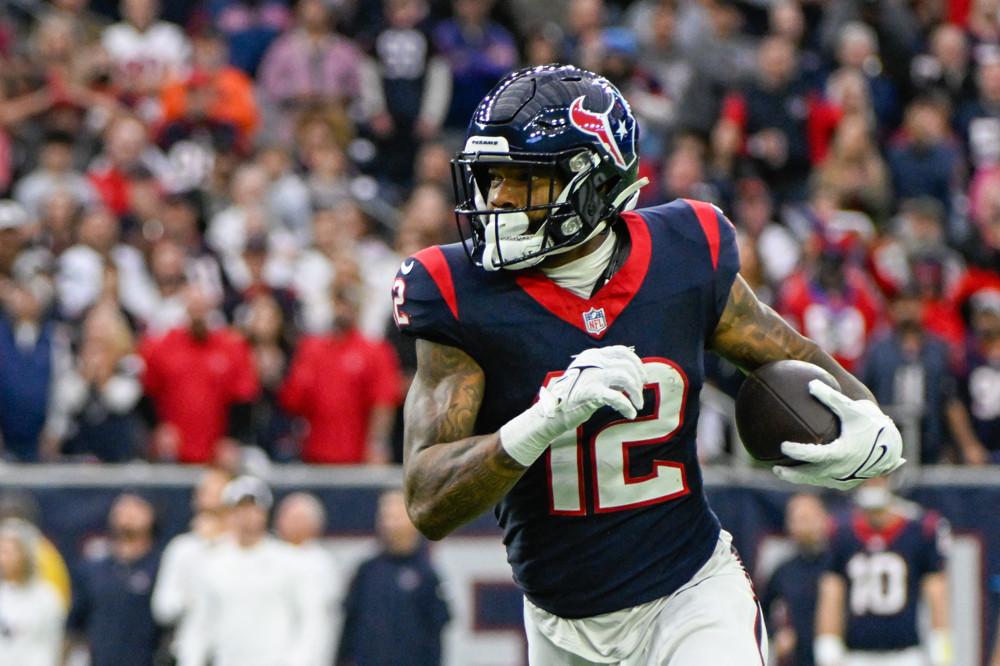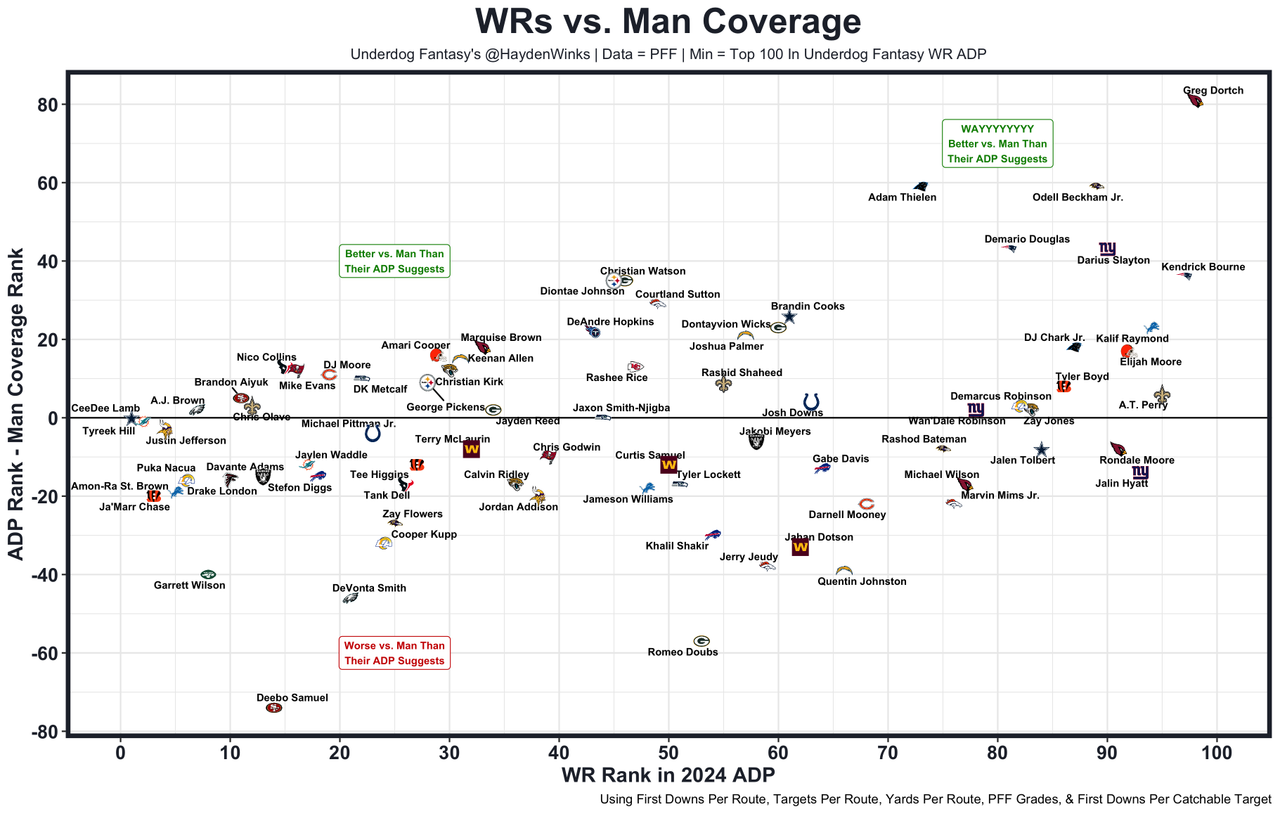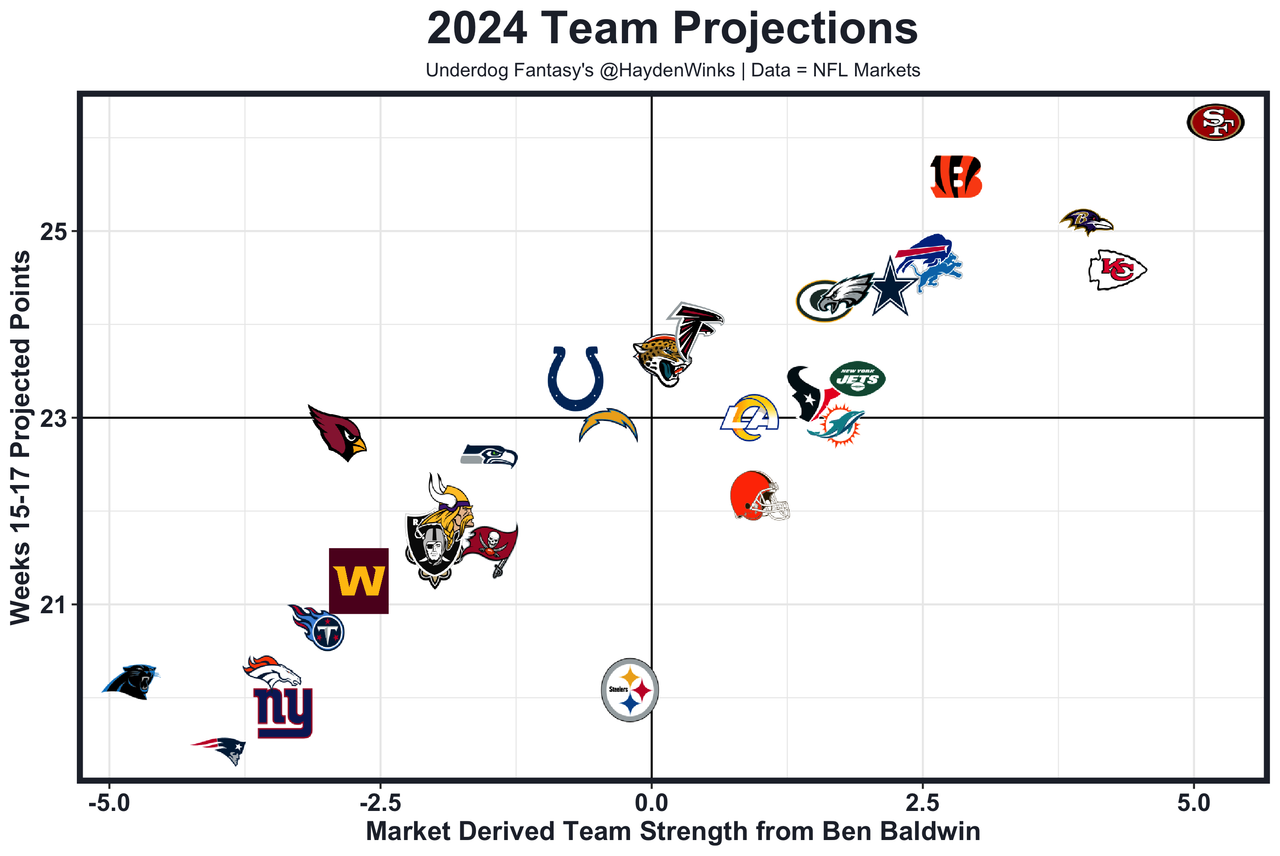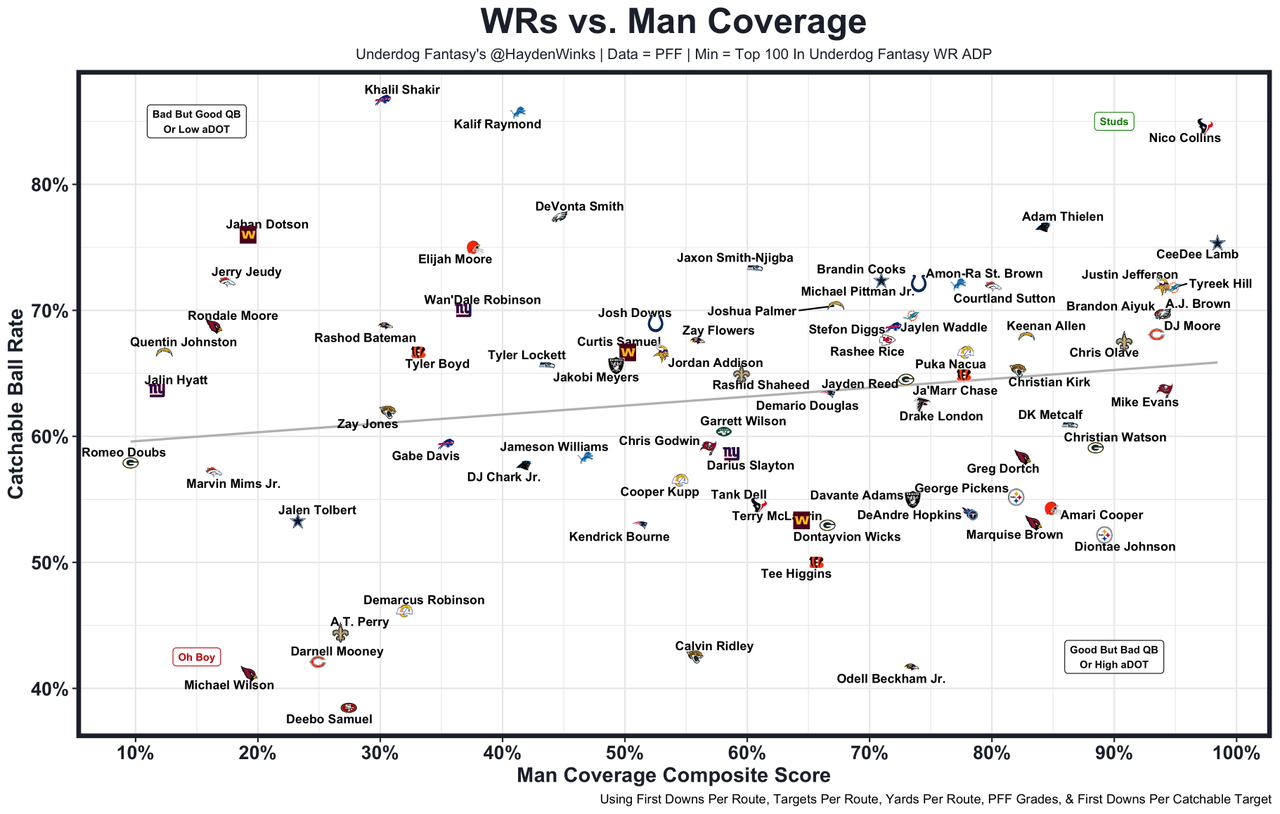The Best WRs Against Man Coverage

The NFL is mostly zone coverage nowadays because defenses are fearful of explosive plays downfield, but there are key spots when defenses need to play man coverage and when offenses need their top WRs to step the hell up. Today's column is looking into the alpha receivers heading into the 2024 season. All of this 2023 season data is from PFF.
To be clear, just because a WR is good or bad against man coverage doesn't mean they have to be a good or bad fantasy football pick. There are WRs who are better against zone or are in such a good team environment that they can afford to not be one of the best WRs in the NFL when windows close.
2023 WRs vs. Man Coverage
The columns are percentile rankings for the various man coverage only reps.
ADP Rank: The WR ranking in average draft position on Underdog Fantasy ahead of the 2024 season.
Composite Score: The weighted average of PFF Grade, TPRR, YPRR, FDRR, and Adjusted FDRR. It's the best accurate metric of the ones listed in this column.
PFF Grade: Their film assessment on plays against man coverage only. There was a minimum of 50 routes run, leading to 117 WR qualifiers.
TPRR: Targets per route run. It was the worst performing metric of the ones listed, but in theory, the best receivers will be targeted on a high percentage of their man coverage routes. Unfortunately, the metric is relatively poor with dealing with teammate competition and how effective their targets are.
YPRR: Yards per route run. A generally reliable number that slightly skews towards more explosive WRs, WRs attached to elite QBs, or WRs without much teammate competition.
FDRR: First downs per route run. The most predictive non-composite metric in the column because first downs are better than raw yards in general. There can be noise in yards because a random big play (potentially on a broken coverage) can skew the yardage total or because a receiver who catches largely meaningless underneath yards on 3rd-and-longs can skew the yardage total.
Adjusted FDRR: Adjusted first down per route run, attempting to account for inaccurate passes and general offensive environment. I took each WRs first down percentage on their catchable target to assess how many theoretical first downs each WR lost because of an uncatchable pass. The formula = (First Downs + Theoretical First Downs) / Routes Run. We'll get to catchable target rates later in the column.
Biggest Differences With 2024 Underdog ADP

This chart ranks the players in composite man coverage score from their 2023 season and compares that ranking with where each WR is being drafted on Underdog Fantasy this upcoming season. Players below the black line on the chart were worse against man coverage than their 2024 ADP suggests, while players above the line were better than upcoming expectations. Of course, there is a varying range of context missing for each player. Let's get into it.
Nico Collins: Here's how he became the WR2 overall in composite score: 98th percentile PFF grade, 93rd percentile targets per route, 98th percentile yards per route, and 99th percentile first downs per route. Not only was Collins' athleticism too much to handle in the route, but he was also fantastic in creating yards after the catch. If the Texans' long-term extension wasn't enough to sell Collins to you, then these numbers should. He's a top-10 NFL receiver based on the tape despite being the WR15 in Underdog Fantasy ADP.
Garrett Wilson: So much of this was likely the Jets' awful QB play. While these metrics are better than others at separating WR play from QB play, it's still imperfect. I fully expected Wilson to be among the best against man coverage with a somewhat healthy Aaron Rodgers in 2024. His individual tape is fantastic.
Deebo Samuel: A big piece of context with Deebo's concerning graph placement is that only 38% of his man coverage targets were catchable, per PFF. That was alarmingly low compared to other WRs as you'll see in the next section of the column ... When healthy, Deebo has the athleticism to run right by corners in man coverage, but he isn't the technician as a route runner that the other borderline top-15 WRs are. Samuel can get caught in the press coverage blender and doesn't have the length to constantly win on breaking routes. Instead, Samuel is dominant against zone coverage and in the manufactured touch department because he's a load to tackle. That trend will continue with Kyle Shanahan, who needs Brandon Aiyuk (WR6 in composite score) to shred in man coverage and downfield.
DeVonta Smith: Some of his relatively poor showing here can be blamed on two things: the Eagles disastrous play against the blitz last year and A.J. Brown being the WR5 in composite score against man coverage. Individually, Smitty is more good than great against man coverage because of his frame, but he's great against zone coverage because of his feel. There is an argument to be had that his ceiling with a healthy AJB is lower than his fantasy football draft cost. This chart supports that.
Cooper Kupp: It was obvious that he wasn't himself for large chunks of last season. Kupp was just in the 54th percentile against man coverage, compared to Puka Nacua's 78th. The veteran was still seeing more targets per route (30%) than the stud rookie (24%), but he was doing far less with them (1.2 YPRR vs. 2.6 YPRR). Hopefully his ankle and hamstring injuries go away in 2024, though we've seen this story before with 31 year olds.
Stefon Diggs: The Bills ran the ball effectively and more often in 2023, which was the primary root of Diggs' fantasy football problems. But it wasn't just that. Diggs wasn't as good individually. He checks in at 72nd percentile in composite score, despite playing with an MVP-contending QB. Diggs' first downs per route vs. man coverage were only in the 64th percentile, and he didn't seem quite as athletic in general. The Bills put him in the slot at his 2nd-highest rate of his career, leading to a decreased 10.8 average depth of target. With the Texans, Diggs is likely to play a ton more slot snaps next to outside dominators Nico Collins (WR2 in man coverage composite score) and Tank Dell (WR43, but also elite vs. zone coverage). To me, Diggs' career is in decline.
Marquise Brown: The counting numbers were awful, but Brown still had some juice on tape. The balls just didn't end up anywhere near him when working downfield. Only 53% of his man coverage targets were catchable with the Cardinals' QBs last year, a problem completely flipped by attaching himself to Patrick Mahomes in 2024. When adjusting for his uncatchable targets, Brown was in the ... wait for it ... 94th percentile in adjusted first downs per route. Rashee Rice was only in the 69th percentile there, and a lot of Rice's man coverage reps were on mesh concepts, pick plays, and whip routes. Hollywood is likely better at the real receiver stuff.

DeAndre Hopkins: Hand up. He was better than expected in 2023. Hopkins isn't in the old Larry Fitzgerald role yet. He won downfield with the Titans and continued to hold his own against man coverage. Hopkins' 78th percentile composite score equates to the WR21 overall, which is a lot earlier than his WR43 price tag despite the upcoming offense appearing far more modernized. The risk is Calvin Ridley coming over, but Ridley was worse in PFF grade, yards per route, and way first downs per route (47th percentile vs. 83rd percentile) than Hopkins was last year. The age cliff approaches both of these WRs, but if they replicate their 2023 film and numbers, it's Hopkins who has the advantage despite being drafted later than Ridley on Underdog Fantasy.
Courtland Sutton: There were so many downfield grabs Sutton made than very few humans walking the earth could dream of making. He was a great receiver in a bad situation, but the numbers back that up. Sutton was in the 80th percentile in composite score and even in the 86th percentile in first downs per route, which is the best stat to look at other than composite score. Moving forward to this season, his competition for targets are Josh Reynolds (50th percentile), Marvin Mims (16th percentile), 4th-round skinny rookie Troy Franklin, and the ghost of Tim Patrick. Don't be surprised if the Broncos' new-look offense with the distributing Bo Nix increases Sutton's overall targets. He's good enough to have surprising volume. I'm smashing Sutton at WR49 on Underdog, and I'm proud of it.
Diontae Johnson: Those 2023 Steelers... Yikes. Both Diontae and George Pickens cleared the 90th percentile in yards per route vs. man coverage, but Pittsburgh was so bad at passing that teams never gave them opportunities to work in man coverage. In fact, I had to re-do my charts in this column because DJ didn't clear my initial threshold of man coverage snaps. In these small samples, Diontae was fantastic at drawing targets (92nd percentile) and turning his catchable targets into first downs (97th percentile). QB play remains a concern with the Panthers, but there's little doubt that Diontae will immediately step in as the alpha in the Carolina offense. 1st-round rookie Xavier Legette has a lot of rust to be polished off before he becomes a primary target in my opinion.
Adam Thielen: He didn't have the juice to turn the corner after the catch, nor did he have the juice to win downfield last year, but Thielen was quite crafty around the first-down marker. He surprisingly was in the 91st percentile in first downs per route last year despite being in an awful offense. Thielen has far better teammate competition (see Diontae Johnson above) this time around, but it'd be a stretch to see him completely phased out of 2-WR sets barring a breakout Xavier Legette season. Thielen was the WR14 in composite score as a 33-year-old.
Romeo Doubs: The Packers essentially leaves Doubs out to dry in man coverage. He led the team in isolated WR snaps as the primary X receiver, while "easy" targets were schemed up for Jayden Reed, Christian Watson, the RBs, and the TEs. Doubs turned in a bottom 10th percentile composite score vs. man coverage, though I don't think his tape is quite that bad. Just don't expect him to constantly run by or break ankles against press coverage. Doubs' man vs. zone coverage splits were among the widest in the entire NFL last year. We'll see if the Packers stick him at X receiver and plug their nose again... I'm open to Dontayvion Wicks getting a shot at that role in 2024 after he was in the 67th percentile as a rookie:
Odell Beckham: The Ravens slow-played his return from injury and never made him a full-time player during his age-31 season, but Odell was quietly decent on a per-route basis. He was the WR30 in composite score versus man coverage and would've performed better if not missed by Lamar Jackson on a few downfield opportunities. The numbers tell that same story. OBJ was only in the 53rd percentile in first downs per route, yet was in the 81st percentile in PFF grade and in the 86th percentile in yards per route. The Dolphins also rotate their WRs to keep them fresh, but I'm taking Odell more seriously than others as a Round 17-18 dart throw. There's at least contingent upside if something ever happened to Tyreek Hill or Jaylen Waddle.
Darius Slayton: The Giants were a disaster last year. They should be better if Daniel Jones is somewhat healthy and if Malik Nabers is anywhere near as elite as I think he is, so there could be a few best ball dart throws that hit in this offense. Slayton is my favorite. He was in the 59th percentile in composite score vs. man coverage, compared to his teammates Wan'Dale Robinson at 37th percentile and Jalin Hyatt at 12th percentile. Hyatt's tape is better than that score, but the non-Slayton WRs are relatively small and slot-dominant. Slayton is the best option at X-receiver and his $7.8M contract backs that up. He'll be one of my highest drafted players if he continues to be available in Round 17-18.
Greg Dortch: The streets are fitting him for a gold jacket, and I understand why. Dortch is too small for outside reps, but he is frisky in 3-WR sets, especially next to physical WRs and TEs. That's exactly the Cardinals formula on paper with Marvin Harrison Jr. (X), Michael Wilson or Zay Jones (Z), and Trey McBride (TE) towering over Dortch underneath. Last year, Dortch was in the 83rd percentile in composite score vs. man coverage. Wilson was at 19th percentile. Current Falcon Rondale Moore, 16th percentile. If you want to prioritize Dortch in the last round of best ball tournaments, then this is statistical evidence to continue doing so. Worse case, we'll have fun tweeting about how good Dortch is.
Catchable Targets In Man Coverage

WRs listed below the line were disproportionally effected by poor environment or ran cold on deep-target variance. Meanwhile, players listed above the line were in solid environments or played near the line of scrimmage.